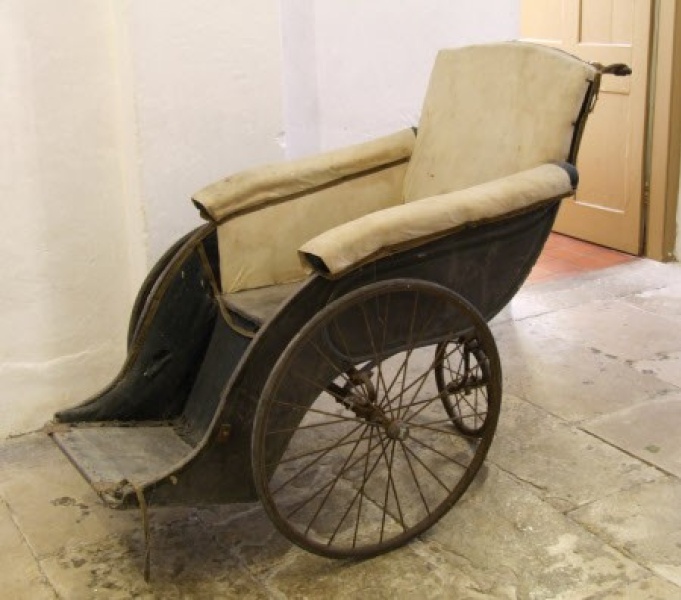Listed in 1 collection
Listed at 1 museum
Listed for 1 maker
Quick Details
Carriage Type
Invalid Carriage
Date of Production
1900
Accession or Inventory Number
NT 137716
Materials used
Paint, Wood, Iron, Steel, Leather, Wool Box Cloth, Ivory, RubberSummary of Invalid Carriage
Invalid Carriage built by Alfred Carter, of 47 Holborn Viaduct, London designed to be propelled by an attendant. The body of this carriage is panelled body with a curved profile and is sprung on cross springs. There is a high seat back, long arm rests, and a deep foot rest with panelled sides. The turned wood pushing handle is on curved iron stays bolted to the back of the body. There are half hinges at the front of the foot rest showing that a framed apron was originally fitted, and studs beneath the arm rests for a leather apron above this. Neither apron has survived. Upholstered in dark blue and undyed cloth. Painted dark blue with pale blue lining
Invalid carriages were designed either to be pulled by a small pony or donkey or pushed along by a servant, relative or friend. This example is person propelled via the carved wood handle at the back. They were a means of enabling the elderly or infirm to take some air. This invalid carriage is unusual as it has two wheels at the front and the single wheel at the back.
Dimensions
Height: 3ft 7 3/4"
Length: 5ft 1"
Width: 2ft 9 1/2"
Full description
This is a three-wheeled invalid carriage with, unusually, the single wheel at the back. It has a panelled body with curved profile, a high seat back, long arm rests, a deep foot rest with panelled sides and a turned wood pushing handle on curved iron stays bolted to the back of the body. There are half hinges at the front of the foot rest showing that a framed apron was originally fitted, and studs beneath the arm rests for a leather apron above this. Neither apron has survived.
The carriage has bicycle style wire wheels with black solid rubber tyres on grease axles. The hind wheel is fitted in a fork that turns, enabling it to act as a castor. Its bearing is at the back end of a Y-shaped stay that connects it to the axle. A cross spring is connected to scroll irons under the back of the body and bolted to the Y-shaped stay. Another cross spring is connected to scroll irons at he ends of the axle and bolted to the centre of the body
The body is painted dark blue with very nice pale blue double fine lines. All the ironwork is black. The body is lined with dark blue wool cloth, probably buttoned but this cannot be seen because the seat back, arm rests and side squabs have been covered with an undyed cotton cloth, presumably because the original linings are badly damaged. The seat cushion is missing. Surprisingly it appears that the foot rest was covered with the same cloth and all but fragments around the edge is missing. Floor cloth would be more usual. Much of the original triangle pattern pasting lace is in place, some obviously removed and refitted on the relatively recent cotton cloth. It is badly faded and impossible to determine its original colour.
Inscriptions
On a circular ivory plate on the upper back rail: ALFRED CARTER 47 HOLBORNVIADUCT LONDON E.C.
Access information
This Invalid Carriage is in the care of the National Trust at Uppark.
Uppark
South Harting,
Petersfield,
West Sussex,
GU31 5QR
Picture credit
National Trust / Andrew Fetherston

 Carriage Foundation
Carriage Foundation